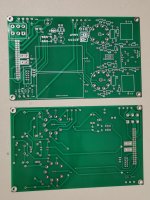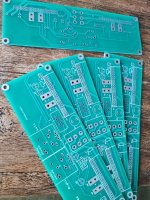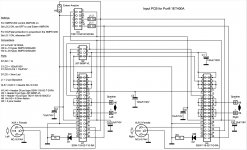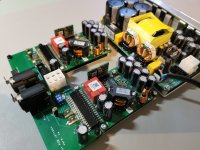The unbuffered purifi amp has the less colouration I experienced until yet.
It is not only about adding distorsion. Also very important is the change of slewrate and frequentie depending fase shift.
How do you know when you add distortion, etc. via tubes what exactly is responsible for the change in sound you perceive? Is it the slew rate, the phase shift? the added distortion? Some combination?
Because of my experience with several types of tubes in several applications. And analyzing the complete audio chain.
I can write a book about what phase shift and slewrate does with the perception of music.
But i have no formula for the best sound.
But most important is to learn what sound you like. And that you can only achive by listen to as much as different setups and start building your own equipment. This proces i am doing now for 45 years and still learning, what a great hobby.
I can write a book about what phase shift and slewrate does with the perception of music.
But i have no formula for the best sound.
But most important is to learn what sound you like. And that you can only achive by listen to as much as different setups and start building your own equipment. This proces i am doing now for 45 years and still learning, what a great hobby.
@Koifarm, thank you for the great work!
we finally finished the pcb build and been listening for few days, we like the sound very much, thank you again.
the 5687 does get hot a bit, with 250v psu i think its almost at it's threshold, is there possibility to use lower V ?
would you be interested to design the buffer with DHT tubes such as 2A3/300B/45? 😀
we finally finished the pcb build and been listening for few days, we like the sound very much, thank you again.
the 5687 does get hot a bit, with 250v psu i think its almost at it's threshold, is there possibility to use lower V ?
would you be interested to design the buffer with DHT tubes such as 2A3/300B/45? 😀
The 5687 has no stress. it runs below half of it maximum specs.
I have no interrest of making design for 2a3 or 300b. These are powertubes, an overkill for preamps/buffers.
I have no interrest of making design for 2a3 or 300b. These are powertubes, an overkill for preamps/buffers.
good to know. thanks for the infoThe 5687 has no stress. it runs below half of it maximum specs.
I have no interrest of making design for 2a3 or 300b. These are powertubes, an overkill for preamps/buffers.
I have three PCB's for the unbuffered input board to share. Just for the shippingcost. If interested send me a PM.
https://www.diyaudio.com/community/...urifi-1et400a-amps.379211/page-2#post-6981958
https://www.diyaudio.com/community/...urifi-1et400a-amps.379211/page-2#post-6981958
Attachments
You can use jack to rca adapter when using the neutrik ncj6fah chasis part. Or connect shield to pin 1 and 3 and signal to pin 2.
About humm.
I had no humm issues when using smps for anode and heater voltage with ground joint together. I used the mu follower topology.
Also opamp buffers have no humm or noise.

About humm.
I had no humm issues when using smps for anode and heater voltage with ground joint together. I used the mu follower topology.
Also opamp buffers have no humm or noise.
Last edited:
Thanks, the hum question was for the SE-BAL adapter.
I am rebuilding a Gradient sub for my ESL63, and want to configure it as monoblocs inside the speaker enclosures.
Jan
I am rebuilding a Gradient sub for my ESL63, and want to configure it as monoblocs inside the speaker enclosures.
Jan
Clear, i had never humm problems when converting balanced to SE. I am using behringer dcx and deq and dbx balanced equipment and hypex/purifi/sure amp modules.
Hello Koifarm, is it possible to change the gain on the 6n6p board? I was hoping to have it switchable between 13.2db and 7.2db.
Thanks
Thanks
The feeback is now configurated with R9 and R10(R19 and R20) to 3 x gain(9.5db) or 9 x gain(19db).
You can change this gain by changing the feedback resistors. Try 33k for R9(R19) and 120k for R10(R20).
Maybe you must adjust the values when it is not enough or too much gain.
You can change this gain by changing the feedback resistors. Try 33k for R9(R19) and 120k for R10(R20).
Maybe you must adjust the values when it is not enough or too much gain.
Thank you for the info and the great project!The feeback is now configurated with R9 and R10(R19 and R20) to 3 x gain(9.5db) or 9 x gain(19db).
You can change this gain by changing the feedback resistors. Try 33k for R9(R19) and 120k for R10(R20).
Maybe you must adjust the values when it is not enough or too much gain.
Question to you cognocienti. Purify says that you can use their front end with an unbalanced single ended (aka RCA) input - just connect XLR input pin 2 to RCA hot, and both XLR 3 and Gnd to RCA Gnd. We discussed above, but this is another issue.
If you do that, and run it through LTspice*, you'll see that the level at the non-inverting output of the buffer is about twice the amplitude of the inverting buf output.
Of course, the pk-pk amplitude is the same independent of the connection, provided the input level remains the same.
But. Let us assume that the actual Purify power amp consists of two modules, driven in antiphase and bridge-driving the speaker.
In the case of the RCA input, one module gets double the input level than the other which means that it will clip much earlier than the other.
The total output amplitude, unclipped, is thus much lower than when driven through the balanced XLR input.
Of course, if the Purify power stage is truly differential, it wouldn't matter. But I dunno ...
Thoughts?
Jan
*In the attached sim, two situations: both inputs at 0.5V, or one input at 1V and the other at 0V.
If you do that, and run it through LTspice*, you'll see that the level at the non-inverting output of the buffer is about twice the amplitude of the inverting buf output.
Of course, the pk-pk amplitude is the same independent of the connection, provided the input level remains the same.
But. Let us assume that the actual Purify power amp consists of two modules, driven in antiphase and bridge-driving the speaker.
In the case of the RCA input, one module gets double the input level than the other which means that it will clip much earlier than the other.
The total output amplitude, unclipped, is thus much lower than when driven through the balanced XLR input.
Of course, if the Purify power stage is truly differential, it wouldn't matter. But I dunno ...
Thoughts?
Jan
*In the attached sim, two situations: both inputs at 0.5V, or one input at 1V and the other at 0V.
Attachments
Last edited:
Follow-up: Bruno quite adamantly chastised me for even suggesting the power modules would not have fully balanced inputs ...
Issue closed.
Jan
Issue closed.
Jan
I think the balanced input of the 1et400a (and hypex modules) is converted to single ended. Then the classD magic happens. Also loudspeaker - out is referred to Vee, that you do not expect with a balanced output stage.
- Home
- Amplifiers
- Class D
- Universal PCB for Purifi 1ET400A amps



